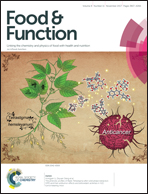Fortified beeswax oleogels: effect of β-carotene on the gel structure and oxidative stability
Abstract
This study was aimed at evaluating the physical conformation and oxidative stability of beeswax oleogels when fortified by the incorporation of β-carotene (complex-beeswax oleogels). Rheological evaluation showed the presence of a strengthened structural conformation in the oleogels with β-carotene in comparison with that in oleogels without β-carotene; this was verified by the increase in rheological parameters. Small angle X-ray scattering data show that the lamellar crystal structure of the oleogels with β-carotene exhibits similar d-spacings and lower radius of gyration (Rg) values for all concentrations due to the stronger oleogel network. X-ray diffraction measurements provide useful information on the crystal polymorphism type and arrangement of the internal lamellar phases of the crystals. Oil binding capacity is also affected by the incorporation of β-carotene into the oleogel and proven to be higher for the complex-beeswax oleogels, which enhances the ability of the oleogels to retain an oil phase within their crystalline network. The oxidative profiles of the complex-beeswax oleogels were studied during storage, and beeswax at the concentrations of 4, 6, and 8% revealed higher oxidative stability than that at the concentration of 2%. In this study, the possibility of tailoring the properties of oleogels is demonstrated considering the foreseen applications of oleogels in food products, such as in texturizers, as well their capacity to deliver bioactives and thus add value to food products.



 Please wait while we load your content...
Please wait while we load your content...